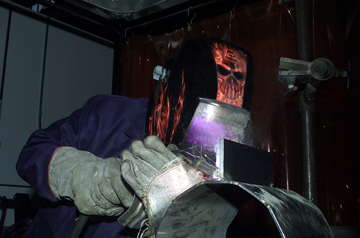Joining A36 Steel to Dissimilar Metals: Know the Material Chemistry and More
While there are any number of dissimilar metals that can be welded together, some combinations are more common — particularly welding A36 steel to other materials. A36 is a popular material used in a variety of industries and applications due to being easily weldable. Following best practices for each material combination is important for gaining the best results. Here are some tips to help you on your way.
Welding A36 to A514
A36 is a low-carbon steel that offers good strength and formability. A514 is a high-strength steel, typically offering a yield strength of 100,000 psi, depending on the grade being used. The combination of the two are often found in:
-Structural welding
-Construction
-Heavy Equipment manufacturing
Typically, when welding these two base metals, choose a filler metal based on the lower-strength material, in this case the A36 steel. Since the strength of the weldment will never be greater than the lowest strength member, it is generally not necessary to match the strength of the A514 material. American Welding Society (AWS) filler metal classifications include:
–E7018 low-hydrogen stick electrodes
–ER70S-6 solid welding wire
–E71T-1 flux-cored welding wire
While filler metal selection is based on the lower-strength metal, you should use the preheat and interpass temperature recommendations for the higher-strength metal, which in this case would be A514. Preheat and interpass temperatures are more critical for the higher-strength metal and can minimize cracking and loss of strength.
Welding A36 to 4130A36 steel is commonly joined to AISI 4130 — a low-alloy steel that contains molybdenum and chromium as strengthening agents — particularly in heavy equipment welding. AISI 4130 is commonly used for components such as shafts or machine components.
Again, the filler metal choice is usually dependent on the strength of the lower-strength base metal of the two. Low-hydrogen filler metals that provide 70 ksi tensile strength are a good option for welding A36 steel to AISI 4130 in this situation. These include:
-E71T-1/9/12 flux-cored welding wire
-E7018 low-hydrogen stick electrodes
Follow the proper preheat and interpass temperatures for AISI 4130 base metal, which is most successfully welded in the annealed condition. Preheating and interpass temperature control helps prevent rapid cooling that could lead to cracking. The specific temperatures depend on the thickness of the AISI 4130 base metal and previous tempering temperature (if welded in the heat treated condition). See chart below. The original heat treat condition should be investigated before determining preheat/interpass temperatures if welding is to be done in the heat treated condition.

Welding A36 to AR plate
Abrasion resistant (AR) steel plate is often used for heavy equipment or mining equipment — inside the bed of a dump truck, for example — to extend service life in harsh conditions. It is a low-alloy steel that is typically quench and tempered and rated for use only as a wear plate.
There is no industry standard governing the processing of AR plate. As a result, its chemical and mechanical properties vary by manufacturer. Preheat requirements or filler metal recommendations will also vary.
70 ksi filler metals are often adequate for welding A36 to AR plate; however, you should contact the AR plate manufacturer for specific filler metal and preheating recommendations to be certain.
Learn about additional dissimilar metal welding applications.
This article is the second in a two-part series discussing considerations and best practices for welding dissimilar metals. Read article one, Preheating and Other Considerations for Welding Dissimilar Metals.



